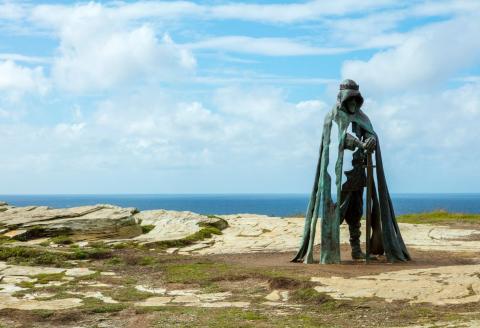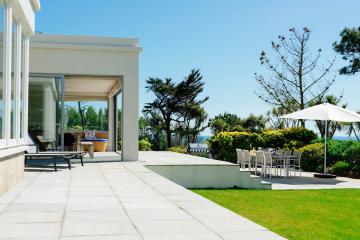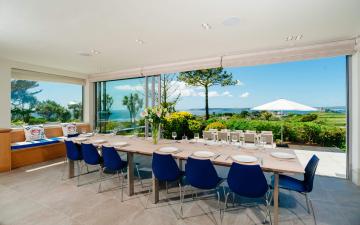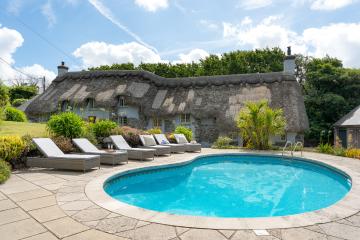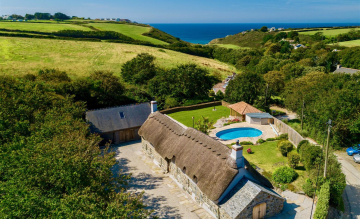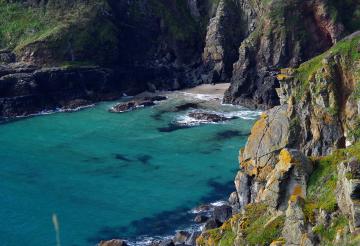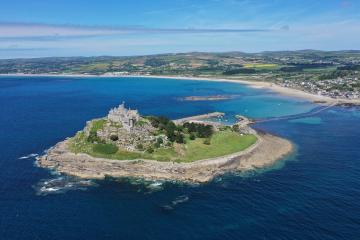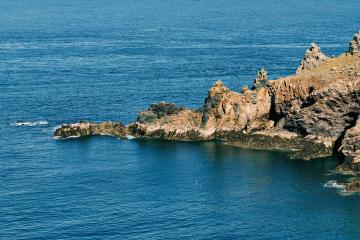Historical landmarks to visit in Devon and Cornwall
Posted by Bethany Walton on Updated onFrom ancient castles to historic buildings, discover the South West's rich heritage
One for history-lovers and curious minds, discover the South West’s most intriguing landmarks, perfect for half term adventures. Plus, with extra recommendations on how to spend a day seeing the sights, you’ll have your staycation itinerary sorted in no time.
Tintagel Castle, North Cornwall
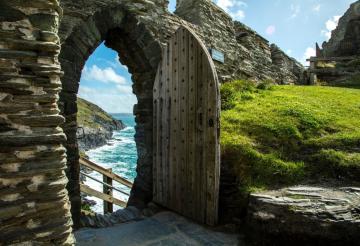
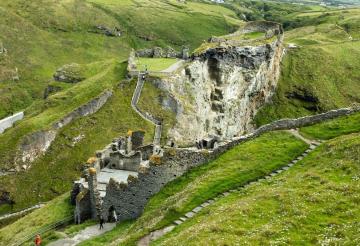
© Matt Jessop
Located high above the rolling waves in rugged North Cornwall, Tintagel Castle is one of the county’s most-loved destinations for a day out. Steeped in legend and folklore, the castle is often referred to as ‘Arthur’s Castle’ because of its links to King Arthur. A magnificent structure stretching across the headland, follow in the footsteps of its medieval inhabitants as you wander around the ruins.
Brave the walk across the castle’s footbridge which sits a staggering 180 feet above the water. Or keep your feet on solid ground and explore the shores beneath the castle at Merlin’s Cave, before seeking out the bronze sculpture of King Arthur on the connecting island.
While here, enjoy walking around the unique town of Tintagel, dipping into the independent shops and cafés. When exploring, you’ll stumble across Tintagel’s Old Post Office – dating back to the 1500s, the beautiful ancient farmhouse is now owned by the National Trust. Peek inside and discover its fascinating hidden history to round off your day.
Castle Drogo, Mid Devon
Newer to the history books, Castle Drogo dates back to 1930 and was the last castle to be built in England. Tucked away in the Devonshire countryside, the mixed-revivalist castle is open to the public to discover its 100-year-old history. Wander around the grounds and climb to the very top of the castle to enjoy spectacular views over the Teign Gorge below. With beautiful gardens filled with colourful blooms, the best time to visit Castle Drogo is in the spring and early summer – visit the sunken rose garden, admire the blossoming rhododendrons and enjoy a moment of tranquillity on the fragrant terrace.
The castle was originally built for Julius Drewe, who owned 450 acres of land to the south and west of the nearby village, Drewsteignton. Stop by on your way back from a day spent at the castle for a stroll around the pretty village. Take a walk around the 15th century church, admiring its beautiful architecture and stained glass windows as you go. Or if you’d prefer a longer walk, head through the woodland towards Fingle Bridge, where you can let four-legged friends splash in the shallow waters.
Caerhays Castle, South Cornwall
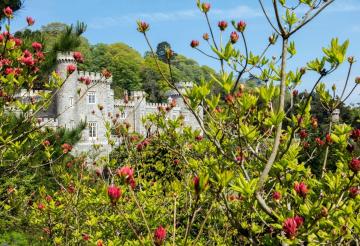
© Matt Jessop
Tucked away on the quiet south coast of Cornwall, near Gorran Haven, Caerhays Castle is known affectionately at the ‘castle by the sea’. Overlooking the golden sands of Porthluney Beach, the castle was built in 1808 and was home to the Trevanion family. Today, the castle is an English Heritage Grade I listed building and is open for visits in the springtime. Loved for its beautiful gardens, you’ll often see incredible blooms of rhododendrons and camellias in the 140 acres surrounding the castle. Inside tells the story of the families who have lived there for the past two centuries, including a treasure trove of Victorian possessions.
Perfect for a day out in the sunshine, wander through the gardens before making a pit stop at the Caerhays Beach Café. A destination for an al fresco lunch, tuck into homemade fishcakes or a falafel burger, before heading down onto the sand. Or stop by The Lost Gardens of Heligan for a stroll around the historic grounds of Heligan House.
Please note Caerhays Castle is only open for visits over Easter, but the gardens are open from February to June.
Geevor Tin Mine, West Cornwall
Recognisable as one of Cornwall’s most famous tin mines, Geevor is now a museum and heritage centre. Not far from St Just, Geevor Tin Mine sits close to the coast and in its day, black tin and copper was mined here. Opened in the 18th century and in operation until 1990, the mine is incredibly important to Cornwall’s heritage.
Go underground and discover the ancient mines, read about the history of metal mining in the Hard Rock Museum and walk beneath the fascinating Victory Shaft which lowered men below ground. Suitable for all ages, children will love donning their hard hats and panning for gold.
If you’re heading back to North Cornwall after your day at the mine, be sure to stop by Tremenheere Kitchen for a late lunch. With a menu dedicated to local produce, enjoy fresh fish dishes and delicious seasonal vegetables, paired with a traditional Cornish cider.
Dartmouth Castle, South Devon
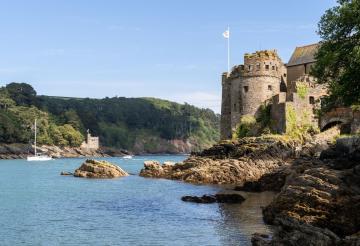
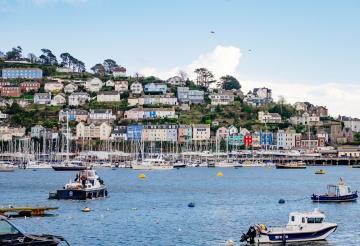
© Matthew Hartley
Sitting perfectly at the mouth of the River Dart, Dartmouth Castle dates back to the 1380s and was built to protect the estuary from French attack. Despite its age, the castle is well-preserved and makes for an intriguing wander around the ancient keep. Discover the gun tower, cannons, and ‘secret’ passages beneath the Old Battery.
Built on rocks just above the estuary, the castle is picturesque. Amble through the woodlands that surround the castle or stretch your legs further with a walk into Dartmouth, just 30 minutes away along the water. Home to the Britannia Royal Naval College, you may even see the naval boats practising as you go by.
Alternatively, you can opt to see the castle from a different perspective and head out on a boat trip along the estuary. Spot wildlife as you go and look up at the castle in awe as you reach the top of the river.
St Nectan’s Glen, North Cornwall
Not far from Tintagel, St Nectan’s Glen is an enchanting valley with a spectacular 60-foot waterfall. One of Cornwall’s Areas of Outstanding Natural Beauty, the glen is also thought to be one of the country’s most magical places. Not only does legend state St Nectan’s Glen is home to mischievous Cornish Piskies, but many also believe it has connections to King Arthur. Let imaginations wander while exploring the woodland, before arriving at the sparkling pool beneath the waterfall.
If you’ve got your welly boots on, wade through the shallows beneath the waterfall and enjoy views across the mystical woodland. Depending on the weather, warm up with tea and cake or choose your favourite scoop of ice cream on sunnier days at The Tree of Life Café.
The Minack Theatre, West Cornwall

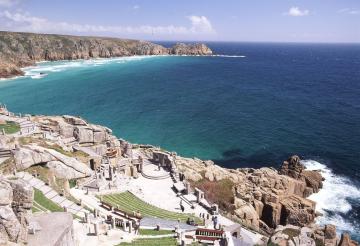
© The Minack Theatre
An open-air amphitheatre on the very edge of Cornwall’s rugged west coast, The Minack Theatre promises something special. Opened in 1930, the theatre was designed and constructed by Rowena Cade. Following the First World War, the locals of Porthcurno wanted a place to perform plays by Shakespeare, and so Rowena offered her incredible back garden as their stage. Since then, the theatre has provided an incredible setting for nearly 100 years’ worth of plays and productions – in the most beautiful locations.
The best way to visit is to see a show, of course. Discover the fascinating story of the theatre and how it came to be with the Moving Heaven and Earth show, run by actor Billy Rawlings. Once you arrive, weave your way down the winding pathway until you reach the rows of seats, staggered into the gradient of the cliff. Made of stone, we recommend taking a cushion for a comfier seat. As the waves crash into the rocks below, its easy to see why The Minack is such an awe-inspiring location and one not to be missed during a trip to Cornwall.
On summer days, be sure to pay a visit to one of Cornwall’s hidden beaches on the west coast. Just around the bay from The Minack Theatre lies the magical Nanjizal Cove and Pedn Vounder Beach, where afternoons soaking up the sunshine await.
If you’re planning a trip to The Minack Theatre, it’s strongly advised that you book in advance to avoid disappointment. For more information, visit their website.
Exeter Cathedral, South Devon
Magnificent in size and structure, Exeter Cathedral is recognisable for its gothic design and high vaulted ceiling. Built in the 1400s, the Norman building stands in the centre of Exeter surrounded by green lawns, boutique shops and brasseries. The western front is the most impressive part of the building with intricate medieval carvings, while the views from the top stretch right across Exeter.
Sitting on the River Exe, the city is steeped in history and its Georgian-inspired architecture makes it truly beautiful. Not far from the cathedral, take a look around the Royal Albert Memorial Museum & Art Gallery where you’ll find interesting exhibitions and collections on the city’s past. Alternatively, explore from a whole new perspective with an underground tour. Fun and informative, walk through the 14th century tunnels beneath Exeter and be entertained with tales of the past.
Before heading home, stop for a late lunch at Eat on the Green where you can enjoy views over the cathedral. Or head further into town to Gandy Street for an early supper - with cobbles underfoot and close-knit buildings, it’s thought to be the inspiration behind JK Rowling’s Diagon Alley.
Restormel Castle, South Cornwall

© Robert Pittman
Sitting high on the hill above the picturesque town of Lostwithiel, the ruins of Restormel Castle are well worth a visit when in the area. Built in the early 1200s for the first Duke of Cornwall, the castle is one of the best preserved keeps in the country. Distinguishable for its circular structure and motte, Restormel Castle is one of four Norman castles in Cornwall, alongside Launceston, Tintagel and Trematon.
When visiting, be sure to walk along the top of the castle to enjoy spectacular views over the town below and across to Fowey Valley in the distance. On warmer days, pack a picnic and lounge on the luscious green lawn or walk through the pretty woodland to reach The Duchy of Cornwall Nursery where delicious lunches await.
Bodmin Jail, Mid Cornwall
A pinnacle of Cornwall’s history, Bodmin Jail is one of the most recognisable historic sites in the county. Built in 1779, the jail was in operation until 1927. Today, visitors can discover its dark tales and ex-inhabitants with guided walks around the old prison. A great way to spend a rainy day for adults and children alike, Bodmin Jail will certainly pique the interest of curious minds - walk through the ancient prison blocks, take a look inside the cells and uncover the mechanics of the administration room.
Having recently undergone a multimillion pound refurbishment, Bodmin Jail is now home to The Chapel Restaurant. A new recommendation from our Concierge Team, the fine dining restaurant is the perfect place to enjoy an evening meal after exploring.
Burgh Island, South Devon
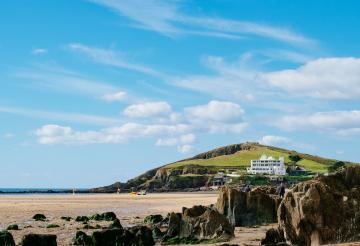
When in South Devon, Bigbury-on-Sea is a must-visit beauty spot. Not only do the miles of golden sand and gentle waves offer peaceful days spent by the sea, but the iconic Burgh Island is also worth a look around. Known for its literary links to Agatha Christie, the island is only accessible via the sea tractor when the tide is high. Once ashore, the walk around Burgh Island takes around 30 – 40 minutes.
Most notably, the art deco hotel that looks out onto the sea was used in the Second World War as a centre for wounded RAF personnel. Though it was damaged in the war, the hotel has since been restored and is now one of the most recognisable buildings in the UK. Once home to Agatha Christie, Burgh Island provided the inspiration for two of her novels; Evil Under the Sun and And Then There Were None.
Where to stay nearby
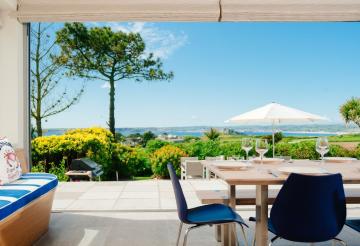
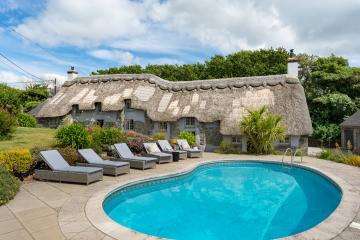
If you’re a history-lover visiting Cornwall and Devon, take some inspiration from our most loved properties. Plan a trip to Marazion with a stay at Ednovean House or enjoy exploring the best of Cornwall with a long weekend at Laflouder Thatch. Speak to our team to start planning your South West staycation: 01208 895 570.
Image credits: Caerhays Castle, Tintagel Castle and The Minack Theatre: Matt Jessop via Visit Cornwall | Restormel Castle: Robert Pittman via Visit Cornwall | Dartmouth Castle: Matthew Hartley via Visit Cornwall | All other images are our own.
Posted by Bethany Walton
Beth can usually be found on a Cornish beach or enjoying a swim in the sea. She has great insight about where to visit across the county, plus plenty of recommendations for finding the best Cornish ice cream.


